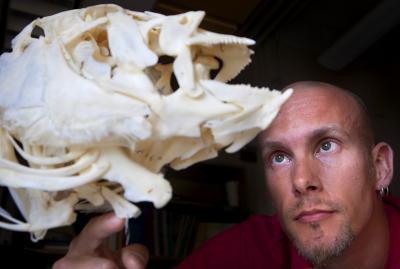The finding was bolstered by earlier research by other scientists that showed the same chewing pattern in other fish, including bichir (a freshwater fish in Africa), gar, and, importantly, lungfish, which is believed to represent an early stage in the transition of some species from exclusively water- to land-dwelling.
In this paper, Konow and his team studied how the muscles of three mammals acted during chewing: alpacas, goats, and pigs. They outfitted each with electrodes planted in the jaw and tongue muscles to pinpoint the activity of each set of muscles during chewing. The analysis indicated that the animals' tongues thrust forward, and upward, as they began to chew and then fell back, or retracted, to their original position. With the animals facing left, the tongue traces an ellipse in a counter-clockwise direction for each cycle.
The distinction between fish and mammal chewing is likely there for a reason, Konow said. With fish, the tongue's function is to transport the food quickly into and through the mouth, where, in many species, an extra set (or sets) of jaws will grind the food. In addition, the tongue moves oxygenated water through the mouth to the gills, helping the fish to breathe.
"That's why you want to constantly have that inward movement with the tongue," Konow explained.
Mammals, on the other hand, use their tongues to set the food in the right spot in the mouth to maximize chewing. But even among closely related species, there is a surprising difference: Herbivores, such as alpacas and goats, were less coordinated during chewing than omnivores, represented by the pigs. Cud-chewing animals were not as monotonously rhythmic in their chewing as many would believe.
"It is a puzzling finding," Konow said. "We think the herbivore needs the bolus (the soft mass of chewed food) to be in a precise place between each chew. So the tongue may be constantly moving around to make sure the bolus is in the right place between chews."
Next came the task of figuring out where, when and with what species the divergence in chewing emerged. Previous research by Anthony Herrel, a Belgian biologist now based at the Museum National D'Histoire Naturelle in Paris, showed that lizards fire their tongues forward and upward as they begin chewing, just like mammals. The thinking is that the transition likely occurred among amphibians. That makes sense, Konow said, and he plans to look next at amphibian chewing. "They're still locked to the water for reproduction," he said. "But you have some that become all terrestrial. And that's the next step on the evolutionary ladder."

Brown University evolutionary biologist Nicolai Konow led a team that has teased out the difference in chewing between fish and mammals. Now, the question is where, and with which species, that difference arose.
(Photo Credit: Nicolai Konow, Brown University and Anthony Herrel, Museum National D'Histoire Naturelle)

Brown University biologist Nicolai Konow and colleagues have learned that fish chew differently from mammals. The evolutionary divergence likely occurred with amphibians, though further research is needed to identify which species and when.
(Photo Credit: Mike Cohea, Brown University)
Source: Brown University